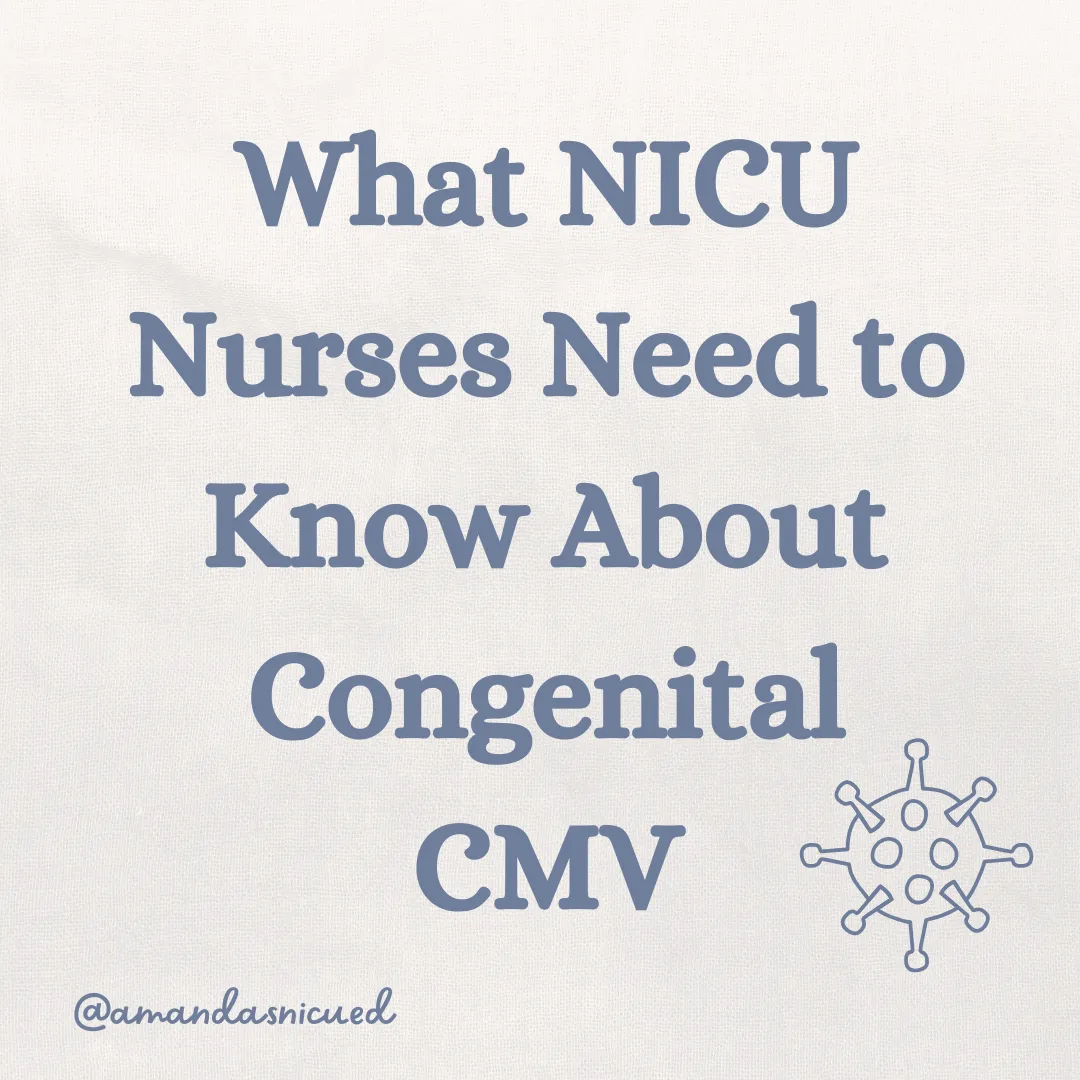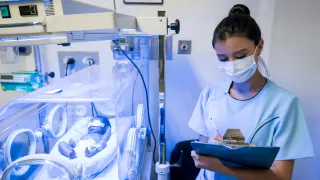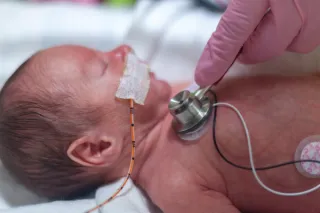
Welcome to Amanda's NICU Education




Hi! My name is Amanda. I'm a NICU nurse, Clinical Nurse Specialist, NICU Educator... basically your NICU BFF. If you want to talk NICU, I'm here for you! I love everything about NICU nursing and I'm eager to learn and share my knowledge with all my NICU friends.
I have been a NICU nurse since 2009 I am currently a Clinical Nurse Specialist in a Level IV NICU in Los Angeles.
I am passionate about educating the next generation of NICU nurses. I share my knowledge through platforms such as Instagram and Facebook and am excited to have you here on my website!
Click on the button below to sign up for my newsletter filled with NICU education and tips for all experience levels.

Not very many people love taking tests but as a self-acclaimed "forever student" who has taken (and passed) five different certification exams I am no longer afraid of tests! "Way to brag", you might be thinking but I want to help YOU pass your certification exam too!
Introducing Amanda's RNC-NIC Success digital course - your ultimate study companion!
Gain unlimited, on-demand access for life, ensuring you're primed to ace your certification exam.
I'm here to help you succeed and I can't wait for you to share with me that you PASSED the RNC-NIC EXAM!!!










CMV
I recently learned that June is CMV awareness month. Let's take a moment to review CMV....
What is CMV? 🩺
Cytomegalovirus (CMV) is a very common type of virus. CMV is part of the herpes family and affects 1 in 200 infants at birth, with 1 in 5 having birth defects. According to the CDC, over half of adults are infected by CMV by the time they are 40.
CMV is found in body fluids, like saliva, blood, breast milk, seminal and vaginal fluids. Mother's who experience a primary infection (first time they're ever infected) early in pregnancy have infants who experience that most sequelae.

Learn More from the CMV Foundation
Pathophysiology
Cytomegalovirus (CMV) causes injury to the fetus through a combination of viral activity, the mother's immune response, and placental changes. The damage often results from the virus actively replicating and destroying cells, as well as inflammation from the body's attempt to fight the infection.
Several factors influence how severe CMV-related injury can be:
Timing of Infection: Infection earlier in pregnancy poses a higher risk.
Maternal Immune Status: A mother's immune defenses can impact fetal outcomes.
Placental Health: Placental damage can lead to growth restriction and poor oxygen delivery.
Viral Load: Higher amounts of virus in the amniotic fluid are linked to worse outcomes.
Strain Differences: Some CMV strains may be more harmful than others.
Fetal Immune and Genetic Response: How the fetus responds at a cellular level also plays a role.
The placenta is central to fetal injury, with CMV infection causing inflammation, disrupting normal placental function, and contributing to intrauterine growth restriction (IUGR).
The fetal brain is especially vulnerable, with CMV affecting brain development by:
Disrupting neural migration
Increasing neural cell death
Altering normal brain structure and immune function
Other organ systems can be affected, including:
Ears (leading to sensorineural hearing loss from inflammation of inner ear structures)
Eyes
Liver
Lungs
Kidneys
Endocrine glands
CMV-infected cells have been found in critical structures like the cochlea, semicircular canals, and vestibular system, explaining the high risk for hearing loss and balance issues in affected infants.
Clinical Presentation
Only about 10-15% of babies with congenital CMV show symptoms at birth, but when they do, it can affect nearly any organ system ranging from mild illness to severe, life-threatening disease.
Common Signs in Symptomatic Newborns Include:
Growth concerns: Prematurity and small for gestational age
Visible symptoms:
Jaundice
Hepatosplenomegaly (enlarged liver and spleen)
Lethargy
Respiratory distress
Seizures
Petechial rash (the classic "blueberry muffin" rash)
This is a common RNC-NIC question
Lab findings:
Thrombocytopenia (low platelets)
Anemia
Elevated liver enzymes and conjugated bilirubin
Central Nervous System (CNS) Involvement is Common
Babies may present with:
Hypotonia (low muscle tone)
Lethargy
Seizures
Microcephaly
Recall the pathophysiology, CMV infection disrupts neuronal migration which results in Microcephaly
Brain imaging may reveal:
Intracranial calcifications
Periventricular cysts
Ventriculomegaly (enlarged ventricles)
Cerebellar hypoplasia
White matter changes
Other Key Complications to Watch For:
Eye disease in 20-40% of symptomatic infants
Retinal scars
Optic atrophy
Chorioretinitis
Sensorineural Hearing Loss (SNHL):
Affects 40-70% of symptomatic infants
Can also affect 10-15% of infants with no other symptoms
May be present at birth or develop later, even into childhood
Hearing loss can range from mild, unilateral to profound, bilateral deafness
SNHL may fluctuate or progressively worsen over time
Outcomes:
Neonatal mortality is rare (likely <5%)
However, 50-75% of symptomatic infants have long-term neurodevelopmental challenges, such as:
Motor impairments or cerebral palsy
Seizures
Vision and hearing loss
Intellectual or learning disabilities
Good news: Most infants with asymptomatic congenital CMV have normal intellectual development, though hearing should still be closely monitored over time.
How is CMV Diagnosed?
Prenatal Diagnosis
Routine CMV screening is not standard during pregnancy, but testing can be done if CMV infection is suspected.
Recommended tests include:
CMV IgG and IgM antibodies
IgG avidity testing to help determine if infection is recent (low avidity = recent primary infection).
Ultrasound clues that may suggest CMV infection:
Echogenic bowel
Intrauterine Growth Restriction (IUGR)
Brain findings: microcephaly, ventriculomegaly, periventricular calcifications
Polyhydramnios, fetal hydrops, hepatosplenomegaly, placental enlargement
Abnormal ultrasound findings increase the risk of long-term complications, while normal cranial imaging is reassuring.
Amniotic Fluid PCR Testing:
Recommended after 20 weeks' gestation and at least 6 weeks post maternal infection
Detects fetal CMV by identifying viral DNA in the amniotic fluid
Postnatal Diagnosis
Best confirmed by detecting CMV in urine or saliva samples collected within the first 2–3 weeks of life.
After 3 weeks, positive results may reflect postnatal CMV infection.
Preferred testing method: CMV PCR, which is more sensitive than older culture methods.
Recommended Evaluation for Diagnosed Infants
All infants with confirmed congenital CMV should receive:
✔️ Complete blood count
✔️ Liver function tests
✔️ Hearing evaluation
✔️ Eye exam (especially for symptomatic infants)
✔️ Cranial imaging (ultrasound and/or MRI)
✔️ Blood CMV PCR to assess viral load
Why it matters:
CNS disease or abnormal brain imaging predicts higher risk for long-term disabilities.
Eye exams are critical for symptomatic infants; asymptomatic infants with normal exams rarely develop later vision issues.
Even infants who pass their newborn hearing screen need ongoing monitoring for delayed or progressive hearing loss.
All infected infants should receive developmental follow-up and early intervention if delays arise.
Future Pregnancies
Mothers with low CMV IgG avidity (recent infection) may need counseling before future pregnancies. Some experts suggest delaying conception until high-avidity antibodies develop, indicating immunity.
Treatment for Symptomatic Infants
Ganciclovir and Valganciclovir, antiviral medications, have been shown to:
Improve hearing outcomes
Reduce developmental delays
Studies show:
6 weeks of IV Ganciclovir improves hearing at 6 months and reduces developmental concerns at 6 and 12 months.
6 months of oral Valganciclovir improves hearing and neurodevelopmental outcomes at 12 and 24 months.
Who should receive treatment?
All symptomatic infants with any CNS involvement, including:
Microcephaly
Abnormal brain imaging
Positive CMV DNA in cerebrospinal fluid
Chorioretinitis
Sensorineural hearing loss (SNHL)
Infants with severe or life-threatening end-organ CMV disease, even if postnatally acquired
Monitoring during treatment:
Neutropenia is a known side effect, requiring careful blood count monitoring.
Infants with CMV chorioretinitis need coordinated care with an ophthalmologist and infectious disease specialist.
What about asymptomatic babies or older infants?
Current evidence does not support antiviral treatment for:
Asymptomatic infants
Older infants with isolated hearing loss
Prevention: The Most Powerful Tool
Since many maternal CMV infections are silent, prevention focuses on education and hygiene:
Key Prevention Tips for Women of Childbearing Age:
✔️ Wash hands after contact with young children’s saliva or urine
✔️ Avoid sharing food, drinks, utensils, or toothbrushes
✔️ Avoid kissing children on the mouth or cheek
Why it matters:
Young children are a major source of CMV for pregnant women.
Surveys show only 14–30% of women have even heard of CMV, highlighting the need for public education.
Prenatal CMV Screening:
Not routinely recommended due to:
Risk of false reassurance from a positive CMV IgG (immunity) result
Possibility of reinfection with a different CMV strain
Future Outlook
No approved CMV vaccines yet, but several are in clinical trials.
An effective vaccine could be a game-changer for preventing congenital CMV in the future.
What NICU Nurses Need to Know About Congenital CMV
CMV is the most common congenital infection and a leading cause of hearing loss and neurodevelopmental delays in infants. As NICU nurses, we play a critical role in early identification, supportive care, and family education.
✔️ Not all babies show symptoms at birth
Only 10–15% of CMV-infected infants are symptomatic
Symptomatic babies may present with:
▪️ Petechial rash
▪️ Jaundice
▪️ Hepatosplenomegaly
▪️ Microcephaly
▪️ Respiratory distress
▪️ Seizures
✔️ Look out for CNS involvement
Microcephaly, abnormal cranial imaging, hypotonia, seizures, or lethargy may signal CMV affecting the brain
Intracranial calcifications or ventriculomegaly on imaging raise suspicion
✔️ CMV is confirmed by testing urine or saliva within the first 3 weeks of life
PCR is the most reliable test
After 3 weeks, positive results may reflect postnatal, non-congenital infection
✔️ Symptomatic infants with CNS involvement qualify for antiviral therapy
Treatment with valganciclovir for 6 months can improve hearing and developmental outcomes
Nurses should monitor for side effects, especially neutropenia
✔️ All infected infants need follow-up
Even asymptomatic infants can develop progressive hearing loss
Ongoing hearing screens, developmental assessments, and early intervention referrals are essential
✔️ Prevention starts with education
Counsel families about CMV prevention—good hand hygiene, avoiding saliva exposure from young children, and not sharing food or drinks
Bottom line: Early detection, appropriate management, and family education can make a difference in outcomes for infants with congenital CMV.
You Make the Difference
Caring for infants with congenital CMV can feel overwhelming—but your knowledge and compassionate care change lives. Early detection starts with the NICU team noticing the subtle signs, advocating for testing, and guiding families through the next steps.
Every time you help a family understand their baby’s diagnosis…
Every time you catch those small details that lead to early treatment…
Every time you teach prevention to a parent or caregiver…
You’re making an impact that lasts a lifetime. 💛
Keep leading with knowledge. Keep advocating for your tiny patients. You’re the difference in their story.
Amanda
Missed my other newsletters? Click here to read them!
References:
American Academy of Pediatrics (2025). Congenital Cytomegalovirus. Retrieved https://www.aap.org/en/patient-care/congenital-cytomegalovirus-ccmv/?srsltid=AfmBOooXbDE0GPEp1IyggPloZ5a8ZeZEi1hQrvmKikubaRAuPS210Zwg
Center for Disease Control and Prevention. (2025). About Cytomegalovirus. Retrieved from https://www.cdc.gov/cytomegalovirus/about/index.html
Stokes, C & Melvin, A. (2024) Viral Infections of the Fetus and Newborn in Avery's Diseases of the Newborn (11th Ed.) Elsevier

December 2023 Certification Review Webinar
NICU Certification Review



Ready to kickstart your journey to becoming a certified NICU nurse?
Look no further!
Grab my FREE E-Book packed with essential study and test-taking strategies for the RNC-NIC.
In the E-Book I give you the resources you need including the link to access the candidate guide, several types of books to study from, some of my favorite strategies, an outline of the content you should review, and a blank calendar for you to make your study plan!
Frequently Asked Questions About the RNC-NIC exam

What is the RNC-NIC?
The RNC-NIC is a competency-based exam that tests the specialty knowledge of nurses in the United States & Canada who care for critically ill newborns and their families.
The RNC-NICU is a nationally recognized certification that recognizes the registered nurse for their specialty knowledge and skill.

Who can take the RNC-NIC exam?
Nurses can take this exam after a minimum of two years experience in the NICU caring for critically ill newborns and their families.

Which books should I use?
I'm glad you asked! There are many excellent books to help you prepare for the RNC-NIC, I gathered ande describe each of them for you in my FREE e-book.
Is there a course to help me study?
Yes! Many hospitals host their own certification course and there are a few online courses. See my RNC-NIC test taking tips E Book for more information
What happens if I don't pass the exam?
If you don't pass the exam on your first try you can try again after 90 days. You will have to reapply after 90 days and pay a retest fee. There is no limit to the number of times you can take the exam (however a candidate can only sit for the exam twice per year).

Can I make more money if I take the RNC-NIC exam and get certified?
Yes! Many hospitals provide a raise or a bonus for nurses with specialty certifications. Hospitals also typically hire at a higher base salary when nurses have a certification.

Find me @amandasnicued on these channels or Email me
hey nurses don't miss out
© Copyright 2024. AmandasNICUEd. All rights reserved. | Terms & Conditions | Privacy Policy Contact: [email protected]

